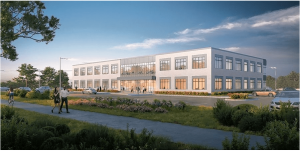
* This story was published in the Daily Herald Suburban Business Section on February 7, 2022 and written by Orrin Schwarz: https://www.dailyherald.com/business/20220205/healing-the-glut-of-vacant-office-space
Employees aren’t just taking their work home with them anymore. More than ever, they’re making their office at home.
So is anybody else wondering what will become of all that space at what used to be the office?
Medical office space, at least in part, is the answer. Over the last six to nine months, that’s become the growth segment in the suburban commercial real estate market, both for new facilities and established real estate.
Soon you might get an MRI or, yes, a vaccine where the copier used to be. Talk to your doctor by the water cooler. Your physical therapist will see you in the conference room.
Vacancy rates in medical office space increased 12-15% in the first few months of the COVID-19 pandemic. But they have since bounced back, and health care providers are expected to fill medical office space at rates of 3-5% over the next two or three years, according to Mark Kinnare, senior vice president of operations at Downers Grove-based Sevan Multi-Site Solutions.
By comparison, the overall office space vacancy rate shot up about 25% by mid-2020 and is not close to returning to pre-pandemic levels. More and more landlords are ready to make the change to medical office space.
“Maybe three to five years ago they would have said, ‘No, I’m going to hold tight, this is what I’m going to lease it as. It’s going to be general office space.’ Because that was the business model,” Kinnare said. “Well that business model doesn’t work anymore, so more and more of them are going to be much more open to the idea of saying, ‘I could take this and it may cost me more to build out that space for this use, but at least I have a tenant in there that will have good credit, is going to pay the rent.’
“You’re going to see more and more of that creative adaptive reuse.”
New facilities too.
Edward-Elmhurst Health opened a 36,000-square-foot facility in Woodridge in October. Northwest Community Hospital opened 80,000 square feet in Buffalo Grove in September. Duly Health & Care opened 50,000 square feet of office space in April.
The York Health Center is 35,000 square feet of medical office space planned for Oak Brook. Oak Brook Commons Medical is 78,000 square feet of medical office space planned for the former McDonald’s Plaza site.
It’s all part of a nationwide work-from-home trend that also is seeing people leaving cities for the suburbs or exurbs. Healthcare providers are bringing the MRI machine and the doctor closer to their patients.
“I think we will always in the United States look for better ways to provide health care solutions to people and we will continue to see innovative cutting-edge practices because that’s going to bring benefit to people,” said Jim Evans, Sevan Solutions President and CEO. “And from a business standpoint that’s going to be the right thing to do for companies that are working to provide those services.”
The big health care centers are shifting noncritical practices like that physical therapist off campuses into office buildings so patient populations don’t mix, a trend that probably will continue. The thought is that it is less expensive and a better experience off a hospital campus. It’s a quicker, more efficient way to treat people.
Oak Brook is a hot area now, NAI Hiffman’s Brian Edgerton said, because of the demographics in the area, easy access via major highways and arterial roads, visibility and supply.
“It’s a real opportunity for a big system to come and plant a really big flag at a high-profile location,” Edgerton said of Oak Brook.
The Naperville area also is popular, as are the Southwest and far West suburbs in general, Edgerton said.
Sevan is seeing new players coming into the health care space also, Evans said. Companies such as Walmart and Walgreens are adding health care facilities to existing stores, giving up traditional retail space in the process to provide space to get a vaccine or test or even to see a doctor.
Mental and behavioral health care is a big part of the growth in medical office space, Edgerton said, whether it be counseling, substance abuse help or behavioral health.
“There’s obviously a market for it and more and more people have found great help from professional behavioral health services. It has been kind of a growth subsector,” he said.
So is that most 21st century kind of health care, telehealth.
“We’re seeing a lot of that kind of planning that’s taking place. People don’t want to miss the boat on that,” Kinnare said.
And that image you have of a doctor or nurse popping open a laptop wherever they can find space? Forget it.
The space for telehealth is being carefully designed, with consideration given to the size of the room, the number of screens needed and soundproofing.
“Northwestern (Medicine) and the major health care providers, especially in the Chicago market, they’re very sophisticated. They have a very sophisticated business model. They’re looking at those trends,” Kinnare said. “They see what’s happening and they’re responding to it.”